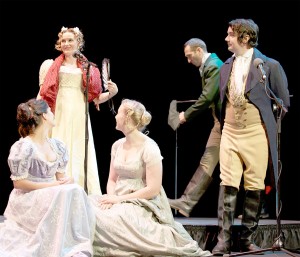Pride and Prejudice stays true to script
Los Angeles Theater Works’ production of Pride and Prejudice is a journey into another era in more ways than one.
Jane Austen’s beloved novel was published exactly 200 years ago Monday, and though any telling of this story is a reflection of that time, LATW’s incarnation of Pride and Prejudice also harkens back to the days before television, when radio was king. Cleverly, the play combines elements of a radio play and a traditional stage play — approriate, considering Pride and Prejudice was recorded and broadcast over the radio.

A classic revisited· Pride and Prejudice at Los Angeles Theater Works’ does not stray far from Jane Austen’s original language and text. – Couresty of Matt Petit
To do that, there are several standing microphones placed around the stage atop a series of raised platforms. There are no sets; instead, images of each setting are projected on a curtain. In the corner sits a table on which several props and a microphone for recording sound effects are placed.
All of the actors, though, appear in period costumes that reflect their characters and interpersonal relationships. Elizabeth Bennet and Mr. Darcy, for example, are the only characters dressed in green, as if a matching set from the very beginning. To contrast this design, Mr. Wickham stands in red, underscoring how his character is in almost every way the opposite of Mr. Darcy.
There is a clothes rack downstage and the actors do sometimes change or add to their wardrobe based on which character they are currently playing. Like a radio play, some of the actors play multiple roles and change their voices and countenances for each role. The only actors who play only one role are the leads, USC alumnus Julia McIlvaine (Elizabeth) and Nick Toren (Mr. Darcy). Even the narrator and foley artist play two other roles.
The multiple characters that are portrayed by the same actors tend to comment upon or contrast one another. For instance, Chloe Dworkin plays both Jane Bennet and Charlotte Lucas, two characters extremely close to Lizzy but very different in temperament and looks. Though Jane Bennet is the woman Mr. Collins desires to marry the most, Charlotte Lucas is the one who eventually becomes his wife.
The characters played by Darren Richardson (Mr. Bingley, Mr. Collins and Mr. Wickham) furthermore, are all strangers and potential suitors for the Bennet girls, but each embodies extremely different qualities of manhood and with varying degrees of worthiness.
Jane Carr also plays two, near-opposite characters — Mrs. Bennet and Lady Catherine — whom represent the silly and the pretentious, respectively. Each of these character changes showcases not only the entire cast’s acting talent, but also its versatility.
The acting in the play is uniformly first-rate, funny and charming. Mr. and Mrs. Bennet (Nicholas Hormann and Carr) are especially hilarious and well-suited to their parts. They both have brilliant comedic timing, particularly Carr.
The adaptation stays very true to the original novel, lifting direct passages of both narration and dialogue, but is compressed to be only about two hours long. But interestingly, the narrator isn’t the only one who speaks the narration. When the narration includes characters’ thoughts, those characters speak those thoughts in the third person, just as they are written in the novel.
The fact that the actors have to speak into one of the many microphones on stage restricts the possibilities for blocking in the piece, and means that they have to get creative in the movements that are possible.
For example, when Mr. Darcy and Lizzy are dancing, very little dancing is actually happening on stage because they are also talking. On the other hand, when Mr. Darcy confesses his love for Lizzy, because of his excitement and eagerness, he gradually jumps from the furthest microphone from Lizzy to the closest. As the tension increases, the distance between their microphones decreases.
The microphone situation has other curious side effects, such as the fact that sometimes the actors are looking not at each other, but rather unnaturally out into the audience. These things add to the disconnection from realism that the style of the play created.
They also, however, add to the awkward comedic tension inherent in Austin’s original piece, which is the area in which this adaptation seems to excel the most. Throughout most of the play, the comedy is the main focus, with the drama largely taking a secondary role. This seems to be a good call: In one performance, the audience was extremely reactive to this, constantly laughing, applauding, ooh-ing, and aah-ing.
It is important to note that despite the occasional forced distance between characters, all the kisses actually do happen. And to add visual depth to some of the scenes, there are characters on stage who do not speak, but congregate upstage as if heavy in conversation. Not everything is microphone-centric.
Ultimately, as long as the casting is solid, it’s extremely difficult to screw up Pride and Prejudice, because the source material is still enormously funny, engaging and endearing, even after 200 years.
The second leg of the national tour of LATW’s Pride and Prejudice kicked off in Cerritos, Calif. on Jan. 25 and continues through Feb. 28.

Comments are closed.